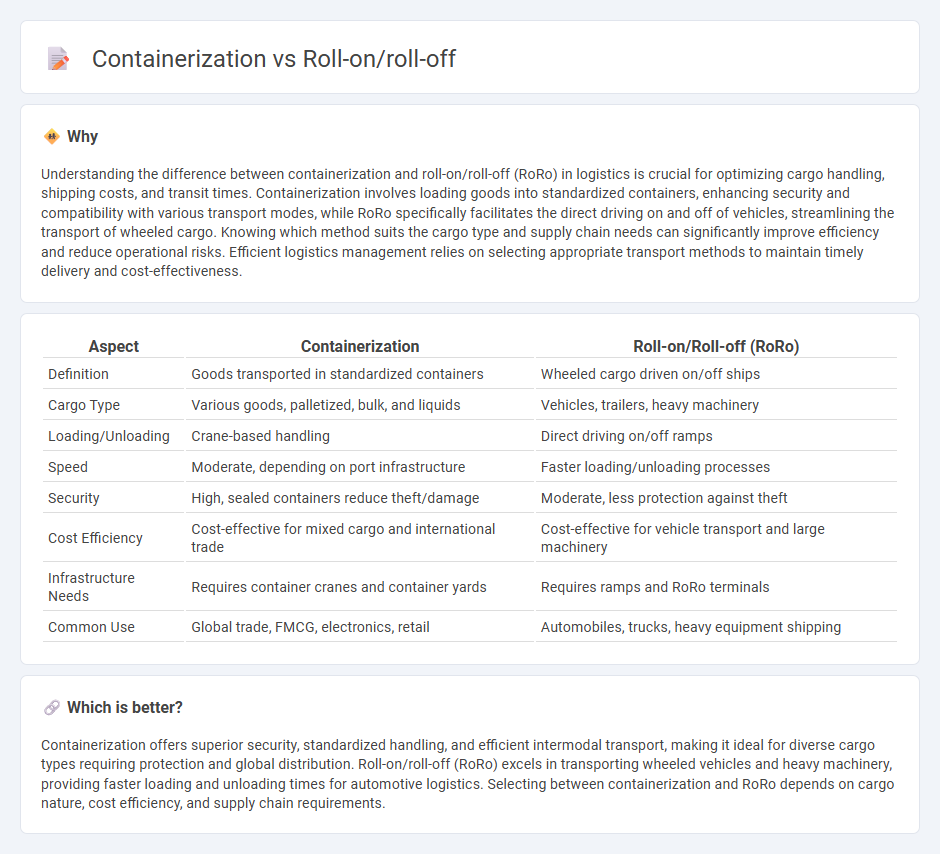
Containerization revolutionizes cargo transport by standardizing load units for efficient handling, secure transit, and seamless intermodal transfers, optimizing supply chain logistics. Roll-on/roll-off (RoRo) shipping specializes in transporting wheeled cargo such as cars and trucks, enabling fast loading and unloading via built-in ramps without cranes. Explore the advantages and applications of containerization and RoRo to optimize your logistics strategy.
Why it is important
Understanding the difference between containerization and roll-on/roll-off (RoRo) in logistics is crucial for optimizing cargo handling, shipping costs, and transit times. Containerization involves loading goods into standardized containers, enhancing security and compatibility with various transport modes, while RoRo specifically facilitates the direct driving on and off of vehicles, streamlining the transport of wheeled cargo. Knowing which method suits the cargo type and supply chain needs can significantly improve efficiency and reduce operational risks. Efficient logistics management relies on selecting appropriate transport methods to maintain timely delivery and cost-effectiveness.
Comparison Table
| Aspect | Containerization | Roll-on/Roll-off (RoRo) |
|---|---|---|
| Definition | Goods transported in standardized containers | Wheeled cargo driven on/off ships |
| Cargo Type | Various goods, palletized, bulk, and liquids | Vehicles, trailers, heavy machinery |
| Loading/Unloading | Crane-based handling | Direct driving on/off ramps |
| Speed | Moderate, depending on port infrastructure | Faster loading/unloading processes |
| Security | High, sealed containers reduce theft/damage | Moderate, less protection against theft |
| Cost Efficiency | Cost-effective for mixed cargo and international trade | Cost-effective for vehicle transport and large machinery |
| Infrastructure Needs | Requires container cranes and container yards | Requires ramps and RoRo terminals |
| Common Use | Global trade, FMCG, electronics, retail | Automobiles, trucks, heavy equipment shipping |
Which is better?
Containerization offers superior security, standardized handling, and efficient intermodal transport, making it ideal for diverse cargo types requiring protection and global distribution. Roll-on/roll-off (RoRo) excels in transporting wheeled vehicles and heavy machinery, providing faster loading and unloading times for automotive logistics. Selecting between containerization and RoRo depends on cargo nature, cost efficiency, and supply chain requirements.
Connection
Containerization revolutionized logistics by standardizing cargo units, streamlining handling and transportation across multiple modes. Roll-on/roll-off (RoRo) ships complement this innovation by allowing vehicles and wheeled cargo to be driven directly onto vessels, enhancing efficiency for specific freight types. Together, containerization and RoRo methods optimize port operations and reduce loading times in global supply chains.
Key Terms
Vehicle Carrier
Roll-on/roll-off (RoRo) ships specialize in transporting vehicles by allowing them to be driven directly onto and off the vessel, significantly reducing loading time and minimizing damage risk compared to containerization. Containerization, while versatile for various cargo types, requires vehicles to be loaded into containers, increasing handling processes and space utilization. Explore the advantages of RoRo vehicle carriers to understand their efficiency in automotive logistics.
TEU (Twenty-foot Equivalent Unit)
Roll-on/roll-off (RoRo) vessels specialize in transporting wheeled cargo, optimizing the loading and unloading of vehicles but offering limited TEU capacity compared to container ships. Containerization centers on stacking standardized containers, dramatically increasing TEU efficiency and enabling global intermodal transport integration. Explore the advantages of each method to determine the best fit for your logistics needs and cargo types.
Intermodal Transport
Roll-on/roll-off (RoRo) and containerization represent crucial pillars in intermodal transport, with RoRo facilitating the direct movement of wheeled cargo such as cars and trucks onto vessels without the need for cranes, enhancing efficiency in automotive and heavy machinery shipment. Containerization, on the other hand, revolutionizes cargo transport by standardizing cargo units, enabling seamless handling across ships, trains, and trucks, thereby maximizing cargo safety and optimizing loading and unloading times. Explore deeper insights into how these methods shape global supply chains and operational efficiencies in intermodal transportation.
Source and External Links
What Is Roll-On/Roll-Off (Ro/Ro) Transportation? - Roll-on/roll-off (Ro/Ro) transportation is a shipping method where wheeled cargo such as vehicles or equipment is driven or towed onto a vessel via ramps for international marine transport, typically used for non-containerized cargo like cars, trucks, or large machinery secured on trailers or roll trailers.
Roll-on/roll-off - Wikipedia - RoRo ships are cargo vessels designed to carry wheeled cargo such as cars, trucks, trailers, and railroad cars that are driven on and off using built-in or shore ramps, contrasting with lift-on/lift-off vessels that use cranes for loading.
What is RoRo shipping? - RoRo shipping is a cost-effective and reliable maritime transport method for vehicles and rolling equipment such as trucks, buses, and agricultural machinery, using vessels fitted with ramps and rolltrailers for easy loading/unloading.
 dowidth.com
dowidth.com